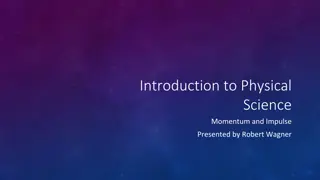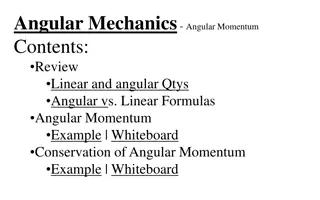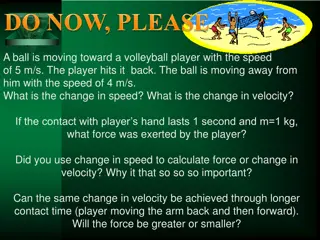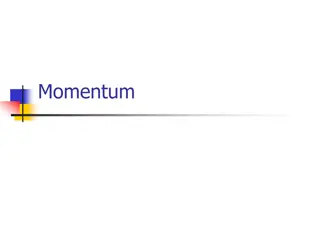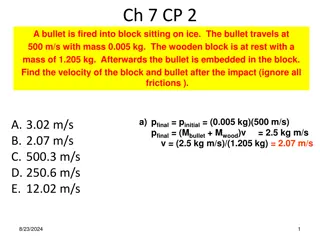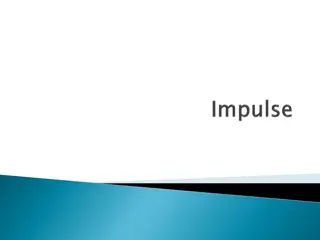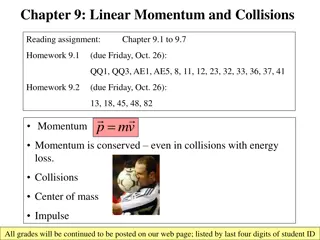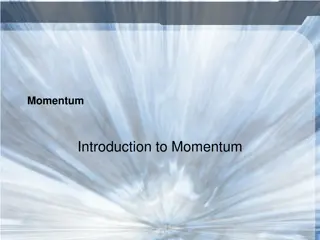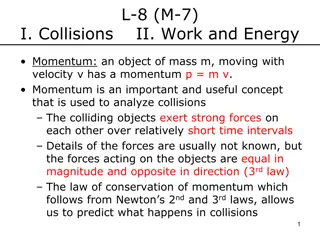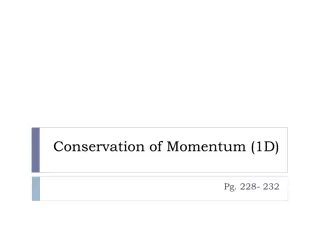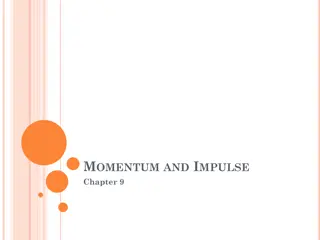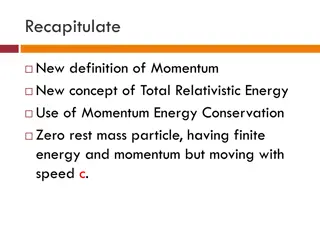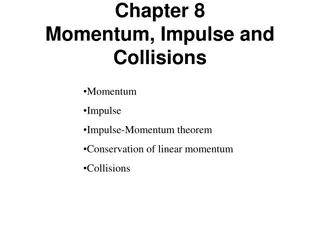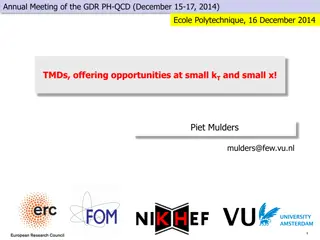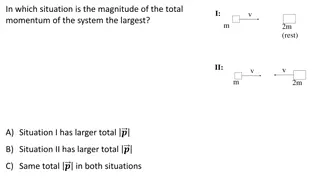MOMENTUM
Momentum is a crucial concept in physics, defined as the product of an object's mass and velocity. Learn about when an object has momentum, how it relates to inertia and motion, and how impulse can change momentum. Explore scenarios comparing momentum between objects of different masses and velocities. Consider the importance of direction and the role of force in altering momentum based on Newton's second law. Discover how the duration of a force's application influences momentum change and how impulse relates to momentum alteration.
Uploaded on Feb 22, 2025 | 0 Views
Download Presentation

Please find below an Image/Link to download the presentation.
The content on the website is provided AS IS for your information and personal use only. It may not be sold, licensed, or shared on other websites without obtaining consent from the author.If you encounter any issues during the download, it is possible that the publisher has removed the file from their server.
You are allowed to download the files provided on this website for personal or commercial use, subject to the condition that they are used lawfully. All files are the property of their respective owners.
The content on the website is provided AS IS for your information and personal use only. It may not be sold, licensed, or shared on other websites without obtaining consent from the author.
E N D
Presentation Transcript
Momentum Momentum-inertia in motion; more specifically, the mass of an object multiplied by its velocity momentum=mass x velocity or p=mv Momentum is measured in units of mass and velocity (ex. Kg m/s)
When does an object have momentum? An object can have a large momentum either if its mass is large, its speed is large, or both. Object must be moving
Is it possible to think that a child on roller skates and a large truck can have the same momentum? Yes, they can have the same momentum if the speed of the roller skater is much larger than the speed of the truck. For example, if the truck is 1000x heavier, the skater would need to move 1000x faster.
Check Yourself A 2 ton car, going 60 m.p.h. hits a 5 ton truck, going 20 m.p.h.. Which vehicle, the car or the truck, has greater momentum? What would the car s speed have to be for the momentums to match? Aren t you forgetting something? How does that matter? 22-Feb-25 Physics 1 (Garcia) SJSU
Direction Direction is important for momentum
Impulse changes momentum In order to change the momentum of an object, either the mass or the velocity must change Mass usually remains unchanged Therefore, velocity changes and the object accelerates. Forces cause acceleration-therefore, force causes a change in momentum
What else is important? How long a force acts determines the amount of momentum change. The longer a force acts, the greater the change in momentum. The quantity of the force x time is called the impulse. The greater the impulse, the greater the change in momentum I=Ft
Impulse Changes Momentum Using Newton s Second Law F=MA and substituting that A= We conclude that Where Ft is the Impulse and M V is the change in momentum V t Ft=M V
Increasing Momentum There are 2 ways to increase the momentum Apply the greatest force possible Apply the force for the longest time possible That is why golfers, baseball players etc., follow through when making an impact
Decreasing Momentum over a long time If you were to fall out of your bed while sleeping, would you rather land on a padded rug or a hard concrete floor? Why? Why are dashboards in cars padded? Why do seat belts and air bags keep people in a car safer?
Automobile Safety Maximizing the time of impact on the driver minimizes the force of impact. This principle used in design of: Crumple Zones Air Bags Seatbelts 22-Feb-25 Physics 1 (Garcia) SJSU
Whenever a collision occurs, the change in momentum is the same, and therefore, the impulse acting on the person is the same. However, the force is what is important. In order to lessen the force of impact, the time is lengthened. In all of the previous examples, the time of impact is increased, decreasing the impact force.
Decreasing Momentum over a short time Examples Riding a bike into a brick wall Not wearing a seat belt in a car collision
Decreasing the impact time for a given change in momentum increases the force imparted. For example, the car comes to an almost instantaneous stop (very low time) so the force on the rider is very great for a given change in momentum.
A karate expert brings their hand swiftly toward the bricks with considerable momentum. The momentum is quickly reduced, causing a large impact force, breaking the bricks.
Bouncing In order for an object to bounce off of another, a greater change in momentum is needed and therefore, a greater impulse and greater force. Imagine the force required to catch a thrown baseball versus catching it and throwing it back. More force is required to also throw it back.
Conservation of Momentum Only external forces change the momentum of objects Internal forces do not change momentum For example, if you are sitting inside a car and push the dashboard, the car will not move because it is an internal force. If a bulldozer pushed the outside of the car, it would move because it is an extrernal force.
Another example The gas inside of a basketball has no effect on the momentum of the basketball. It is not until there is an outside force (a person throwing the ball) that the ball moves
How about a rifle firing a bullet? Force is internal Should be no change in momentum Before the gun is fired, momentum is zero After the gun is fired, the momentum should also be zero Momentum of gun is equal and opposite the momentum of the bullet This is an example of an explosion
Law of Conservation of Momentum In the absence of an external force, the momentum of a system remains unchanged Equation pbefore=pafter or
Explosions Explosion-any interaction where one object is broken into 2 objects because of an internal force Total momentum before the explosion is zero (everything at rest) Total momentum after must also equal zero MaVa=-MbVb
Examples A person standing on a skateboard, jumps off. A rifle being fired Two people on ice skates, pushing back on each other
From the Laser Disc In the toy cannon/bullet example, the mass of the toy gun is 350 grams (.35 kg) and the mass of the bullet is 3.5 grams (.0035 kg). If we find the speed of the bullet to be 1000 m/s, what is the recoil speed of the cannon?
Collisions The Law of Conservation of Momentum can be neatly summarized by the following relationship Total Momentum before collision= Total Momentum after collision
Elastic Collisions An Elastic Collision is when objects collide with no lasting deformation or the generation of heat. Examples Billiard balls Air molecules Calculations will not be covered
Inelastic Collisions An inelastic collision is 2 or more objects collide and become distorted and generate heat. We will consider inelastic collisions where the 2 objects stick together and move off as one. Examples Freight cars coupling together Mashed potatos thrown at someone
Collision Equation Using the law of Conservation of Momentum p(before)=p(after) becomes MaVa + MbVb=(Ma+Mb)Vfinal
Example A freight car of mass 1000 kg is moving at 3 m/s when it collides and couples to a stationary freight car of mass 1200 kg. After the collision, what is the new velocity? Answer- Ma=1000 kg MaVa + MbVb=(Ma+Mb)Vfinal 1000kg(3 m/s) + 1200kg (0m/s)=2200kg (Vfinal) Va=3 m/s Mb=1200 kg Vfinal=1.36 m/s Vb=0 m/s
It is important to note direction Example-John has a mass of 40 kg and Emily a mass of 50 kg. John is skating towards Emily at 2 m/s, Emily is skating toward John at 3 m/s. They collide and move off together after the collision. What is their new speed? *Must make one direction negative* 40 kg (2 m/s) + 50 kg (-3 m/s)= 90 kg (Vfinal) 80 kg m/s -150 kg m/s=90 kg (Vfinal) -70= 90 kg (Vfinal) Vfinal=-.77 m/s Since the velocity is negative, they are moving in the direction of Emily.


